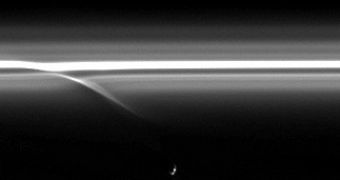Saturn, the celestial version of the “Lord of the Rings,” doesn't just have one ring, as many might believe. In fact, what is perceived from pictures as a single, compact ring is formed of seven distinct smaller ring divisions, labeled from A to F. The main, more massive and compact rings are (from the outermost to the innermost) A, B and C, with D as a fainter, inwards one, almost touching the Saturnine clouds. The F, G and E rings are located outside of the A ring (in this order), and E is by far the widest (302,000 km, comparing to the others which are 5,000 to 30,500 km wide).
There are also other rings of lesser importance (Janus/Epimetheus, the Methone Ring Arc, the Anthe Ring Arc and the Pallene Ring). For more information, go here. Saturn has also 60 moons with a confirmed orbit (of which Enceladus and Titan are the most famous), highly resembling plutoids in shape and orbital form, with the notable exception that they don't orbit the Sun. For a full list and more detailed information, go here.
But Cassini's Saturn flybys revealed that one of the moons is responsible for a very interesting – and especially great to watch – phenomenon. The extremely-elongated moon Prometheus – 86 kilometers in diameter (119 km × 87 km × 61 km), discovered in 1980 – has an orbit that brings it close to the F ring every 14.7 hours. In the aftermath of this faint collision with the ring's extreme edge, its gravity pulls some material from the ring in what is called a “streamer,” leaving a dark channel trail.
This event occurs every time Prometheus attains apoapse (the point where it is farthest away from the planet and closest to the F ring simultaneously), and Cassini took pictures of numerous streamer-channels. The number is further increased due to the fact that the moon is orbiting faster than the ring's material, affecting several places of the ring. Eventually, forces such as the Keplerian shearing one cause the dark channels to disperse. You can also watch a movie of the phenomenon here.

 14 DAY TRIAL //
14 DAY TRIAL //